


APRIL 2023 • Vol.10 • No.04 (ISSN 2564-1999) Themed Edition on Rewards and Recognition in the Workplace
RECOGNITION AND REWARDS STILL
AND
- Logan Mallory, Motivosity The State of Rewards and Recognition 2023 Page 19 - 40 Sponsored by Engage • Reward • Succeed
WHY
MATTER
WILL ALWAYS MATTER
12 The Five Languages Of Appreciation: Understanding How To Show Gratitude In The Workplace
Examining the differences and similarities in the expression of appreciation across various work environments

- Paul White, Ph.D. President, Appreciation at Work
- Logan Mallory, VP of Marketing, Motivosity
41 Calling People Back To The Office Won’t Improve Performance
To achieve performance, everyone needs to know what’s expected of them
- Justin Reinert, Principal and Founder, Performance Accelerated Learning
49 The Return To Work: Navigating Myths And Realities Of Remote And In-Person Work
The future of flexible work arrangements
- Becky Cantieri, Chief People Officer, Momentive
55 How To Prevent Workers From Asking “Why Am I Here?”
Using Herzberg’s two-factor theory and Marrujo’s Cycle of Satisfaction Model
- David Marrujo, Adjunct Associate Professor, Colorado Technical University

Recognition And Rewards Still Matter And Will Always Matter Recognition and rewards can be powerful tools for creating an inspiring employee experience
Why
07 INDEX
Human Experience Excellence - Engagement, Performance, Rewards & Recognition APRIL 2023 Vol.10 No.04 Articles The State of Rewards and Recognition 2023 Page 19 - 40 (ISSN 2564-1999)
On the Cover
Themed Edition on Rewards and Recognition in the Workplace
Effective Recognition In The Workplace: Top Tips To Build A Culture Of Appreciation



Why saying thank you is more than just the cherry on top
- Stuart Smith, Chief
Top Picks 10 15








Innovation Officer, uFlexReward









How Great Leaders Give Impactful Recognition By Focusing On Effort Over Results
Employees want to be recognized for what they are most proud of
- Michelle A. Cadieux, Content Manager, Applauz

Return To Office: Hot Desking And The Power Of Flexible Workspaces
Empowering companies to optimize their hybrid workforce
- Robyn Rawlings, Director of Integrated Campaigns and Content Marketing,
46 52
Webex by Cisco
The Next Step For Worker Experience
Extending a hand to extended workers
of EMEA and Global Client Delivery, Magnit
- Sam Smith, President
INDEX
Human Experience Excellence - Monthly Interactive Learning Journal



The future is all about going beyond the employee experience to focus on human experience. This monthly interactive learning experience showcases strategies and programs to improve employee performance and strengthen your team.
Human Experience Virtual Events
Virtual Events in the Recognition and Engagement track will give you everything you need to recognize and reward employees creating an inspired workforce and organization that will drive innovation and boost productivity. Sessions feature the world’s top thought leaders in the recognition and engagement space covering topics from customer loyalty, safety, sales, company culture and motivation to what makes an effective and efficient results-based program. Each Virtual Event consists of up to 10 credit webcasts.
Human Experience Webcasts for Credit
HR.com webcasts deliver the latest Recognition and Engagement industry news, research trends, best practices and case studies directly to your desktop. Webcasts are available live online with a downloadable podcast and a copy of the slides (PDF) available before and after each webcast. Earn all of the required recertification credits for aPHR, PHR, SPHR, GPHR, and SHRM Certifications. HR.com’s one-hour webcasts, in every HR specialty including HRIS and Payroll, are pre-approved for HRCI and SHRM credit (excluding Demo webcasts).
IHR Rewards and Recognition Community
Join almost 25,600 HR.com members with a similar interest and focus on rewards and recognition. Share content and download research reports, blogs, and articles, network, and “follow” peers and have them “follow” you in a social network platform to communicate regularly and stay on top of the latest updates. This well established Rewards and Recognition Community is an invaluable resource for any HR professional or manager.
SEP 2017 Vol. 5 No. 09 JANUARY 2021 Vol.08 No.01 18 12 25 30 Digital Is All The Rage: Why Employee Rewards Must Include Digital Options In 2021 - Theresa McEndree, Blackhawk Network Employee Experience Trends In 2021Tips To Increasing Your Reward And Recognition Strategies Post-Covid - Richelle Taylor, One10 How To Create Meaningful - Mike Byam, Terryberry HOW TO EMBRACE THE SHIFTS THAT OCCUR AS WE RETURN TO A NEW NORMAL WORKPLACE Key workplace trends for 2021 - David Roberts, Chief E�ecutive �fficer, �lchemer �hemed Edition on Agile Reward & Recognition Strategies How are our Human Experience Products and Services helping to make you smarter? Use these invaluable Human Experience resources today! For more information phone: 1.877.472.6648 | email: sales@hr.com | www.hr.com
Editorial Purpose
Our mission is to promote personal and professional development based on constructive values, sound ethics, and timeless principles.
Excellence Publications
Debbie McGrath CEO, HR.com - Publisher
Sue Kelley Director (Product, Marketing, and Research)
Babitha Balakrishnan and Deepa Damodaran
Excellence Publications Managers and Editors
Human Experience Excellence Team
Babitha Balakrishnan Editor
Arun Kumar R Design and Layout (Digital Magazine)
Vibha Kini Magazine (Online Version)
Submissions & Correspondence
Please send any correspondence, articles, letters to the editor, and requests to reprint, republish, or excerpt articles to ePubEditors@hr.com
For customer service, or information on products and services, call 1-877-472-6648
Debbie Mcgrath Publisher, HR.com
Babitha Balakrishnan Editor, Human Experience Excellence

Rewardsand recognition are two essential elements that have always mattered and will continue to matter in the workplace when it comes to engaging and motivating your people and making them feel included and valued. However, despite recognition being a trending topic in the benefits world, recognition initiatives still fail to take off in most businesses.
To ensure success with these initiatives, it starts with recognizing that the work world has evolved and employees have changed their expectations.
The rise of hybrid work has brought new challenges for organizations regarding recognizing and rewarding employees. With some team members working remotely and others in the office, it can be challenging to ensure that everyone receives equal recognition and rewards.
Recognizing employees for their effort, skills, and unique steps toward the final goal can make a significant difference. However, the problem with recognition that only focuses on outcomes is that it becomes infrequent, and it feels impersonal and generic. Employees may feel like mere "productivity units" working towards delivering business goals, rather than being appreciated for their unique skills and efforts.
Most rewards and recognition programs in organizations are not performing well, according to research by the HR Research Institute. Only a third of HR professionals believe their organization's rewards and recognition initiatives are highly effective. The report explores the effectiveness, design, implementation, challenges, and best practices associated with rewards and recognition programs. Check out the summary and download the complete report, The State of Rewards and Recognition 2023, in this issue.
Why Recognition And Rewards Still Matter and Will Always Matter by Logan Mallory from
Motivosity outlines how recognition and rewards can be powerful tools for creating an inspiring employee experience.
Effective Recognition In The Workplace: Top Tips
To Build A Culture Of Appreciation, the article by uFlexReward's Stuart Smith emphasizes the importance of recognition in the workplace and provides tips on how to create a culture of saying 'thank you' in different ways.
Applauz's Michelle A. Cadieux, in her article, How Great Leaders Give Impactful Recognition By Focusing On Effort Over Results, describes the importance of recognizing employee effort and offers tips on how to identifying what employees are most proud of. It also explores the benefits of recognizing effort over outcomes.

Return To Office: Hot Desking And The Power
Of Flexible Workspaces by Robyn Rawlings from Webex by Cisco introduces hot desking as an office setup made up of temporary workspaces in hybrid work models.
In brief, the April edition of Human Experience Excellence includes articles that focus on the relevance of recognition and rewards in today’s workplace and how by prioritizing and modernizing these elements, HR leaders can help create a positive employee experience that will benefit both the employees and the company as a whole.
We hope you find this edition’s expert articles informative and insightful. As always, we look forward to your valuable suggestions and feedback on our ePublications.
Happy Reading!
employees.
Disclaimer: The views, information, or opinions expressed in the Excellence ePublications are solely those of the authors and do not necessarily represent those of HR.com and its
Under
HR.com
its
or affiliates
incidental damages arising out
no circumstances shall
or
partners
be responsible or liable for any indirect or
of these opinions and content.
EDITOR’S NOTE
OR For Advertising Opportunities, email: sales@hr.com Copyright © 2023 HR.com. No part of this publication may be reproduced or transmitted in any form without written permission from the publisher. Quotations must be credited.
Unlocking the Potential of Rewards and Recognition Programs in the Workplace
Human Experience Excellence (ISSN 2564-1999) is published monthly by HR.com Limited, 56 Malone Road, Jacksons Point, Ontario L0E 1L0 Internet Address: www.hr.com Subscribe now for $99 / year And get this magazine delivered to your inbox every month Become a Member Today to get it FREE! SIGN UP Write to the Editor at ePubEditors@hr.com
In a world of unparalleled challenges (global pandemic, racial injustice, political rivalry, digital 4.0, emotional malaise), uncertainty reigns. Finding opportunity in this context requires harnessing uncertainty and harnessing starts with reliable, valid, timely, and useful information. The Excellence publications are a superb source of such information. The authors provide insights with impact that will guide thought and action.

Excellence publications are my ‘go-to’ resource for contemporary and actionable information to improve leadership, engagement, results, and retention. Each edition offers rich and diverse perspectives for improving the employee experience and the workplace in general.




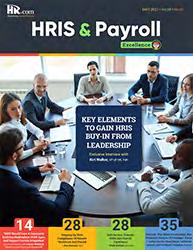

I regularly read and contribute to Leadership Excellence and Talent Management Excellence. I use many of the articles I read to augment my own presentations and I often share the articles with my clients. They are always quick, right on target for the latest issues in my field, and appreciated by my clients. If you want to stay up to date on the latest HR trends, choose a few of the different issues from the Excellence series of publications.

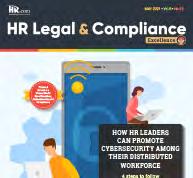
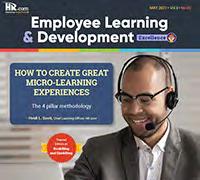


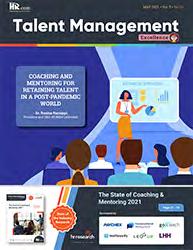
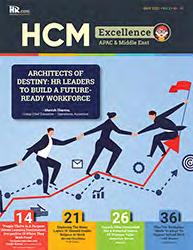
We’re eager to hear your feedback on our magazines. Let us know your thoughts at ePubEditors@hr.com
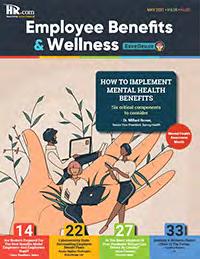
 Dave Ulrich
Rensis Likert Professor, Ross School of Business, University of Michigan Partner, The RBL Group
Dave Ulrich
Rensis Likert Professor, Ross School of Business, University of Michigan Partner, The RBL Group
WHY EXCELLENCE PUBLICATIONS?
Julie Winkle Giulioni Author, Virtual /Live Keynote Presenter, Inc.’s Top 100 Leadership Speakers
Dr. Beverly Kaye CEO, BevKaye&Co.
Why Recognition And Rewards Still Matter and Will Always Matter
Recognition and rewards can be powerful tools for creating an inspiring employee experience
By Logan Mallory, Motivosity
If you are an HR leader, I’d make a sizeable bet you are currently thinking, to some extent, about employee experience. In fact, I bet you think about it a lot. You know that providing a good employee experience results in a ton of benefits for your company, from talent retention to improved employee performance and better overall profitability.
You might also be thinking about employee experience because you know your organization could do better in that area. You’ve heard that nearly 60 percent of workers in the US are experiencing burnout and that 40 percent of workers are thinking about quitting soon. You know that both of those are issues that often stem from poor employee experience.
If you find yourself wishing your organization was paying more attention to the employee experience, let me encourage you
to fight for it. Talk to the decisionmakers, share some meaningful stats with the executive team, and make sure they know how important it is. Then, tell them how you can help ensure your organization is one of the few that provides an outstanding employee experience.
Let me also point you to a powerful tool for improving employee experience that is easy for organizations to overlook: recognition. Taking the time to recognize and appreciate employees is a game-changer in the area of employee experience.
The Benefits of Employee Recognition
Before I share some powerful benefits of employee recognition, let me explain that rewards are not the same thing as recognition. Many companies offer rewards — like gift cards, company swag, or a half-day at the spa — to
those who go above and beyond expectations. Ironically, those rewards are often doled out through an automated system that involves little to no recognition by managers or coworkers of the work that led to the reward.
Good companies offer employee rewards, but great companies don’t stop there. Great companies combine rewards with meaningful recognition to create an environment where employees feel seen, the employee experience improves, and engagement skyrockets.
If you want to clarify the difference between rewards and recognition, think about it this way: rewards might be something team members go after or pursue. Recognition, however, comes after. Whereas rewards are probably given more broadly, recognition is specific to the person.
Human Experience Excellence presented by HR.com April 2023 7 Submit Your Articles
COVER ARTICLE
Recognition happens when a manager or coworker sees an employee doing a good job and says something about it. It feeds the soul in ways no gift card or company T-shirt can.
Today, companies can use modern employee engagement software to provide recognition in a public way, which can inspire others to notice and recognize a job well done. Eventually, this creates a flywheel of gratitude and appreciation that lifts the whole culture of the organization.
Here are some of the benefits that result when companies develop a
meaningful system of recognition and rewards:
Recognition Drives Strong Employee Engagement
Businesses increase employee engagement when they create a workplace culture in which every team member feels their contributions are valued and acknowledged. Healthy, ongoing, relevant employee recognition — from both managers and peers — is one powerful way to achieve that. Showing an employee that they are supporting the company’s goals and values can motivate a deeper commitment to the organization.
Recognition Helps Build Healthy Culture
Company culture should not be approached with a “set-it-andforget-it” mindset. It must receive intentional care, and recognition is a great tool for providing that care.
Recognizing the ways in which employees live out company values helps keep those values front and center. Recognition also shows that you have a culture that values people enough to notice their efforts and recognize them. It creates a culture of grateful employees — and grateful employees are great employees.
Human Experience Excellence presented by HR.com April 2023 8 Submit Your Articles Why Recognition And Rewards Still Matter and Will Always Matter
Recognition Results in Better Peer-to-Peer Communication
As I mentioned, managers who take the time to publicly recognize their employees inspire coworkers to do the same. When recognition becomes part of the culture, it leads to more communication, which builds community. When employees share with the
organization at large the wins that are happening in their particular department, it breaks down silos and builds a stronger culture.
Rewards Are Fun
Did you know that studies suggest having fun at work has a positive impact on employee engagement, creativity, and sense of purpose?
If you want to see more of that
at your workplace, rewards are one way to increase the fun. Want to make it easy? Give cash. It empowers people to reward themselves in whatever way they want, which can be a lot of fun.
These four examples of the benefits of recognition and rewards are just a few of many that I could list. Hopefully, they are enough for you to see that such things still matter in the business world. My belief is that they always will, at least for as long as businesses continue to care about providing an engaging employee experience.
Recommended Resources
1. How to Implement an Employee Recognition Program, Motivosity Blog

2. Why Employees Need Both Recognition and Appreciation, by Mike Robbins, Harvard Business Review
3. Recognition Is a Simple Yet Effective Way to Keep Employees from Quitting, CNBC
Logan Mallory is the Vice President of Marketing at the leading employee engagement and recognition software, Motivosity. Mallory is a public speaker, professor, and thought leader on culture and leadership in the workplace to achieve employee retention.
Would you like to comment?

Human Experience Excellence presented by HR.com April 2023 9 Submit Your Articles
Why Recognition And Rewards Still Matter and Will Always Matter
Effective Recognition In The Workplace: Top Tips To Build A Culture Of Appreciation

Why saying thank you is more than just the cherry on top
By Stuart Smith, uFlexReward
While recognition is trending again in the benefits world, recognition initiatives have still failed to lift off in most businesses.
What is recognition? The Cambridge Dictionary describes ‘giving recognition’ as: “If you are given recognition, people show admiration and respect for your achievements.”
Searching for the dictionary definitions of ‘giving recognition’ revealed a wonderful irony in the context of the workplace – Cambridge offers: “Ella complained that the company never gave her any recognition for her work.”
Google: “Appreciation or acclaim for an achievement, service, or ability; ‘his work was slow to gain recognition’.”
Oxford English Dictionary: “Recognition (for something) public praise and reward for someone’s work or actions; ‘She gained only minimal recognition for her work’.”
The need for recognition in the workplace should be blindingly obvious and most of us are aware that a lack of recognition is demotivating.
While recognition is trending again in the benefits world, recognition initiatives have still failed to lift off in most businesses. Why? The heart of what recognition is all about is often misunderstood, neglected, or adulterated by the schemes, technology, and particularly ‘gifting’.
Human Experience Excellence presented by HR.com April 2023 10 Submit Your Articles
TOP PICK
Give Praise from the Heart
What is at the heart of recognition? Recognition is simply about saying thank you, publicly. Not to say there’s no place in recognition for gifting, but it is the cherry on top. The foundation is remembering to say thank you and doing so publicly.
We all know how nice it is when someone takes a minute to say thank you. And, if they do it in front of the whole team, even more so. Making it public is about ensuring that the people around you – your team and/or your family – know you were thanked and why.
The hard bit, the bit that takes effort to get right, is baking the cake, ie, creating a culture of remembering to say thank you in the business. The good news is that ‘thank you’ is infectious. People who are thanked are more likely to pass it on. Keep feeding it and it will grow into a culture that feeds itself.
Only then can you apply the icing by making it quicker and easier to do it publicly – this is where technology can support, helping remote teams that may struggle to say thank you publicly because they don’t sit in the same office, helping improve visibility of praise by posting in online forums such as the company Yammer page, helping senior managers who want to thank large numbers of colleagues and may struggle
to find the time or to know exactly who they need to thank, helping managers to remember who’s been thanked, for example when assessing performance, and lastly offering digital gifts and vouchers.
So how do you create a culture of recognition? Here are some top tips:
● Lead by example; remember to say thank you more yourself.
● Gather and encourage ‘thank you champions’ who remember to say thank you a lot, particularly those with the forums to do it publicly, such as senior managers.
● Communicate and remind employees how important recognition is, educate them on what it is, and nudge them to remember. Everyone knows and understands how important recognition is and how detrimental a lack of it is, they just need to be reminded.
● Technology can help, but emails, posters, print, a few words at the town hall, are all extremely effective.
● Don’t say ‘give recognition’ it gets misinterpreted. Say ‘give thanks’ or ‘give praise’.
● Let technology initiatives and gifting be pulled by employees, not pushed by HR.
And remember, it’s the thought that counts.
Stuart Smith is Chief Innovation Officer at uFlexReward. He is passionate about transforming rewards into a data-driven, digital function that proves increasing return on investment.
Would you like to comment?

Human Experience Excellence presented by HR.com April 2023 11 Submit Your Articles
A Few Hard Truths About Employee Engagement Surveys
The good news is that ‘thank you’ is infectious. People who are thanked are more likely to pass it on. Keep feeding it and it will grow into a culture that feeds itself.
The Five Languages Of Appreciation: Understanding How To Show Gratitude In The Workplace
By Paul White, Ph.D., Appreciation at Work
We know not everyone feels appreciated in the same way. Using the five languages of appreciation as a conceptual framework, over 350,000 employees worldwide have identified their preferred languages of appreciation and the specific actions most meaningful to them.
The 5 Languages of Appreciation
Based on the NY Times #1 best-selling book, The 5 Love Languages, Dr. Chapman and I applied the concepts to work-based relationships.1 The five languages of appreciation are:
1. Words of affirmation: Verbal praise can be communicated orally or in writing. Common examples include a word of thanks from a colleague for a specific action or an email with a compliment from one’s supervisor.
2. Quality time: Some people feel valued when others spend time with them. This can be
shown either through individual time with their supervisor or being able to hang out with their co-workers.
3. Acts of service: This group prefers appreciation shown through actions. Helping a colleague when they are behind on a time-sensitive project or working together to complete a task are two common examples.
4. Tangible gifts: In the context of workplace appreciation, gifts are not related to compensation (raises, bonuses), but they are small items that demonstrate acknowledgment of one’s teammates – their favorite cup of coffee, a magazine about one of their hobbies or a special snack they would enjoy.
5. Physical touch: Appropriate physical touch in the workplace is a sensitive issue, but the focus is on how people use touch in spontaneous celebration – a high five, a fist bump, or a congratulatory handshake.
Human Experience Excellence presented by HR.com April 2023 12 Submit Your Articles
Examining the differences and similarities in the expression of appreciation across various work environments
To identify how each person desires to be shown appreciation by their colleagues, an online assessment, the Motivating By Appreciation Inventory, was developed. The MBA Inventory assesses an individual’s primary and secondary languages of appreciation, their least-valued appreciation language, and the specific actions most meaningful to them. 2
Over the past ten years, as we have assisted leaders and organizations in identifying the ways their team members desired to receive appreciation, we observed that the specific actions varied significantly across work settings and industries – even within the same language of appreciation. For example, an Act of Service in a medical setting could be to cover a team member’s patient call lights so they can
get caught up on charting, while those who work in schools may value having a colleague watch their class over lunchtime or recess so they can make calls to parents.
In order to provide more accurate and practical information to the test-takers and their colleagues, a number of industry-specific versions of the MBA Inventory have been developed.
One purpose of these different versions was to use appropriate terminology (for example, principal and administrator for schools as opposed to manager and supervisor in businesses). A second goal was to provide action items within each preferred appreciation language that were relevant to the various work settings.
Previous research with over 200,000 employees has documented the preferences for each of the languages of appreciation by employees in general work settings. For the general workforce, 46% choose Words of Affirmation as their primary language of appreciation, 26% choose Quality Time, 21% choose Acts of Service and 7% choose Tangible Gifts (less than 1% choose Physical Touch).

Over 110,000 employees’ results were examined in this study. Employees from five different work settings (government agencies, medical clinics and hospitals, military installations, nonprofit organizations, and schools) and remote employees were investigated. Their results are reported below.

Human Experience Excellence presented by HR.com April 2023 13 Submit Your Articles The Five Languages Of Appreciation: Understanding How To Show Gratitude In The Workplace
While employees in various work settings do vary somewhat in the ways they want to be shown appreciation, the overall themes remain relatively consistent. Words of Affirmatio continue to be the most frequently preferred appreciation language in all but one workplace setting investigated; in military settings, Acts of Service are chosen more frequently than words.
Individuals from four out of the six specific workplace settings continue to choose Words of Affirmation most frequently as their primary language of appreciation, Quality Time second, Acts of Service third, with Tangible Gifts at a distant fourth place.
A trend was observed regarding Acts of Service for those who work in medical settings. While Words of Affirmation were the most preferred appreciation language, Acts of Service was chosen considerably more frequently (31.7%) than Quality Time (20.7%). This may reflect the staffing shortage of medical service providers resulting in an experience of feeling overwhelmed with the amount of work to do.
Additionally, spending time with colleagues while providing medical care for patients is often reported to be practically difficult.
Tangible Gifts Continue to Be the Least Frequently Chosen Preferred Way of Being
shown appreciation, but the rates across work settings do vary – from 2.8% of government employees to 7.9% in medical settings. Not surprisingly, the two settings which have established limitations on gift giving among employees have the lowest rate for Tangible Gifts (government, 2.8%; military, 2.9%). School faculty and staff, however, choose Tangible Gifts at a higher rate (10.3%) than other workplace employees. This may reflect a general sense by school personnel feeling undervalued and under-compensated in our culture, or a higher expectation level to receive gifts.
The desire for appreciation demonstrated through Quality Time rises slightly for those working remotely, for those who work in nonprofit settings, and for school employees. It seems that personal connection
through time together is somewhat more important for colleagues in these settings.
Why This Is Important
Prior research and practical experience have demonstrated that not every employee desires to be shown appreciation in the same ways. When appreciation is shown in the ways most meaningful to the recipient, many positive results occur: a decrease in staff turnover, employee engagement rises, and customer satisfaction ratings improve. During the recent “Great Resignation,” one study found that cultural issues were over ten times more likely to predict employees leaving than compensation issues.3
Understanding the preferences both for individuals and for the general workforce in an industry can assist leaders and HR professionals design appropriate activities to “hit the mark” which will lead to a more engaged and positive workforce.
NOTES:
1. The 5 Languages of Appreciation in the Workplace (2019) by Gary Chapman and Paul White.
2. www.mbainventory.com NOTE: While all five appreciation languages are addressed in The 5 Languages of Appreciation in the Workplace, the language of physical touch is not assessed in the Motivating By Appreciation Inventory to avoid negative reactions by individuals who have experienced sexual harassment in the workplace.
3. Sull, D., Sull, C. & Zweig, B. (2022). Toxic culture is driving the great resignation. MIT Sloan Management Review, 63(2), 1-9.
Would you like to comment?

Human Experience Excellence presented by HR.com April 2023 14 Submit Your Articles The Five Languages Of Appreciation: Understanding How To Show Gratitude In The Workplace
Paul White, Ph.D. is the President of Appreciation at Work
How Great Leaders Give Impactful Recognition By Focusing On Effort Over Results
Employees want to be recognized for what they are most proud of
By Michelle A. Cadieux, Applauz
Giving regular recognition can be a challenge for many leaders.
When we speak with organizations who are starting their recognition journey, we often hear leaders describe the following concerns and obstacles:
● “I don’t have enough time.”
● “I’m not sure what to say.”
● “Will people feel left out?”
Yet, one stands out. Leaders are often confused about when to give employees recognition
When there is uncertainty in this area, it can lead to a common recognition trap; only recognizing employees for big, obvious achievements.
Here are a few examples:
● A designer who receives recognition for re-branding the company website.
● A sales representative who receives recognition for exceeding their yearly objectives.
● A customer service agent who receives recognition for maintaining a high customer satisfaction score that quarter.
Simply put, leaders often default to giving recognition when the following happens:
● High results
● Outstanding output
● Exceeding goals
This is not bad in and of itself. Of course, some recognition is better than none at all, and it’s important to celebrate big wins! Nevertheless, only praising output has a few drawbacks to consider.
The Problem with Only Praising Outcomes
Two main issues arise when recognition is hyper-focused on outcomes:
● Recognition becomes infrequent.
● Recognition feels impersonal and generic.
Human Experience Excellence presented by HR.com April 2023 15 Submit Your Articles
TOP PICK
First, let’s discuss the issue of infrequent recognition.
If leaders only offer recognition when employees have completed something substantial, it won’t happen so often! At most, every couple of months.
Receiving recognition once or twice a year is a great start. But it’s simply not enough to have a lasting impact.
Research supports this claim. One particular study from Workforce Institute found that employees who are recognized at least once per month are 50% more engaged. Another study has shown that recognition frequency correlates with work satisfaction. The more frequent the recognition, the more satisfaction increases.
Second, recognition that focuses on outcomes alone can feel impersonal and generic.
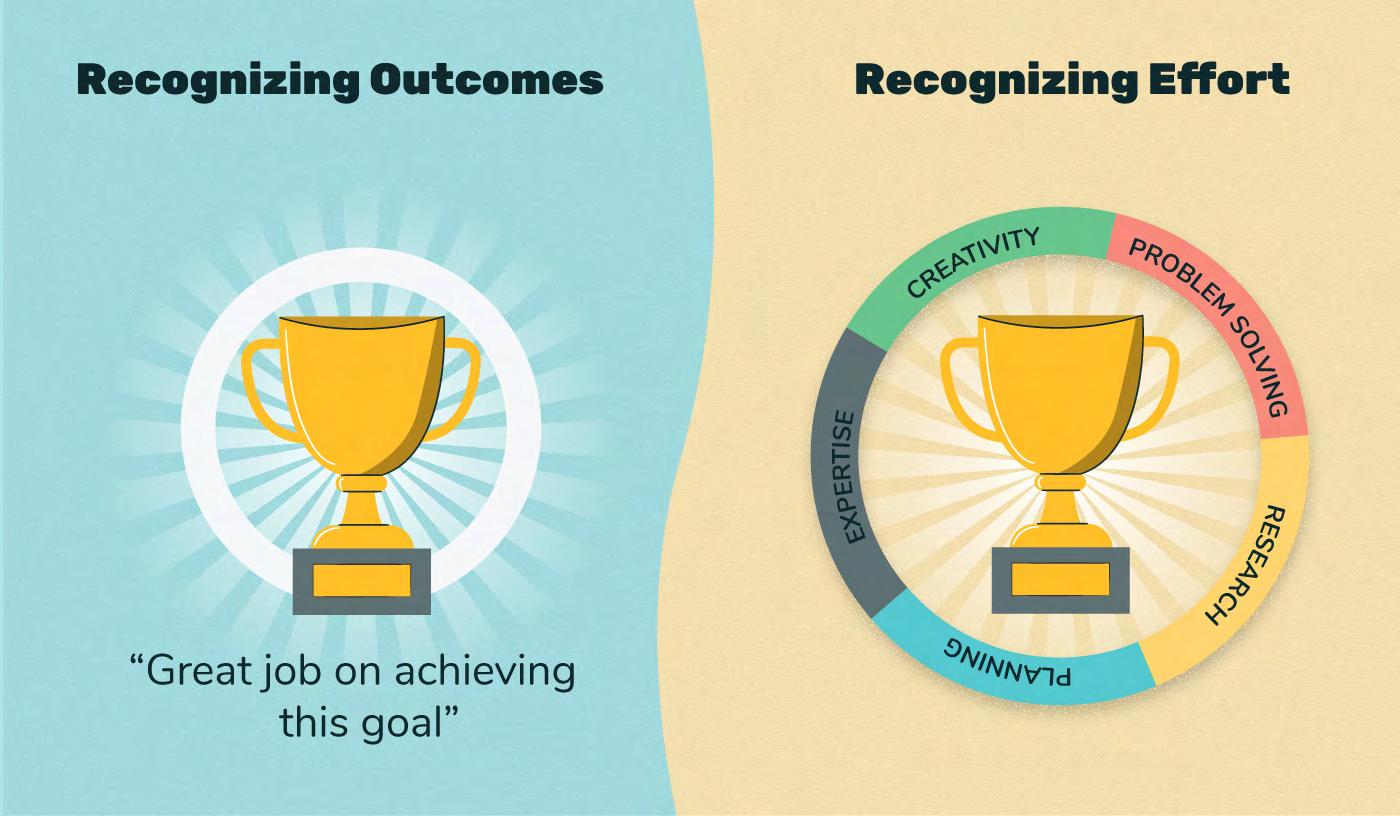
To be clear: praising exceptional results is not the issue. The issue is when a recognition message only consists of that and fails to add extra words that are specific to the employee.
Recognition programs often fail because the recognition is not personal or specific. In short, praise is too focused on productivity and outcomes. This can actually make employees feel dehumanized, like mere “productivity units” working towards delivering business goals.
On the other hand, impactful recognition deliberately calls attention to the unique effort, skills, and steps an employee took to get to the final goal. In short, it highlights what makes the employee special.
Human Experience Excellence presented by HR.com April 2023 16 Submit Your Articles
How Great Leaders Give Impactful Recognition By Focusing On Effort Over Results
This is “authentic appreciation.” This type of genuine recognition is the key to building a successful recognition program and growing appreciation in a work culture.
Ultimately, as we describe in our guide on giving powerful employee recognition, people want to be appreciated for the process. This is where most of the effort goes in and, by extension, what employees are the proudest of.
Think about it like this:
● The sales representative who exceeded their objectives They achieved this goal because of their patience and perseverance — diligently following up and showing strong product knowledge and interpersonal skills.
● The designer who delivered an exceptional re-design of a website. They achieved this because they spent weeks in R&D mode. They researched and drew up a plan with various iterations to understand how to differentiate their design from the competition.
● The customer service agent with a high satisfaction score. They achieved this goal because of their patience, organization skills, and strong ability to make decisions and think on their feet quickly.
Working towards a big goal takes effort. It takes a mix of planning, execution, consistency, discipline and more.
Great recognition will always highlight that effort. It calls attention to the little steps, which likely include challenges and obstacles to overcome.
When you bring attention to the unique skills, processes, and expertise an employee took to get to the final goal, that makes an employee truly feel seen and valued.
Understand What Employees Feel Most Proud of
You might think you don’t have that much oversight of the day-to-day as a leader. Or maybe you’re not
sure what your employees are most proud of or what they’ve worked the hardest on.
We recommend that next time you sit down with an employee at a 1:1, you take the time to ask them:
● What recent contributions are you most proud of?
● What do you feel you’ve put the most effort into recently?
● On the way to achieving X goal, what was your most significant challenge?
You might be surprised to find that the things they are the proudest of have nothing to do with the big results and everything to do with the smaller steps that it takes to get there. Or maybe they took the initiative on a particular task you weren’t even aware of. Or they overcame challenges on the route to a larger goal, and we’re really proud of it.
Once you understand what employees are the proudest of and where they feel they put the most effort, that is where you should focus your recognition. Because when you’re on the same page as your employee, you can learn to give them the appreciation that will have a lasting impact.
The Benefits of Praising Effort
Great recognition hinges on one thing: understanding which contributions employees are most proud of. As a result, the question of “which actions should I recognize” won’t be an issue anymore.
That said, when recognition focuses on effort over the outcome, you’ll start to notice the following happen:
More frequent recognition: When you place a focus on praising effort, you naturally start to recognize the smaller wins that are happening on a weekly or monthly basis. This will make recognition more frequent, and you’ll be more likely to experience the positive impact of appreciation, like higher morale and engagement.
Human Experience Excellence presented by HR.com April 2023 17 Submit Your Articles
How Great Leaders Give Impactful Recognition By Focusing On Effort Over Results
Recognition will feel more meaningful: When you praise effort, recognition by default becomes more personal, and as a result, it feels more genuine and meaningful. Ultimately, it will have a greater emotional impact on the employee as they will feel genuinely valued.
Recognition will influence behavior: By being specific in your recognition, you are providing positive reinforcement; in short, you are telling employees exactly which behaviors you value. This encourages employees to continue with the same behaviors and level of performance.

Greater team harmony: Authentic appreciation makes people feel deeply seen and respected. This boosts feelings of trust and safety. Consequently, the climate of a team will feel more healthy. As a result, there will be less space for toxic feelings and behaviors such as resentment, passive aggression, and gossip.
Final Thoughts
Leaders and managers are busy people. We realize that not every recognition message can be perfectly crafted and inspiring. Sometimes you will only have time for a quick “good job on X,” and that’s OK!
But remember that too many superficial “good jobs” will not have the impact you’re looking for, especially in the context of an official recognition program

Recognizing the “behind the scenes” effort only takes a few extra minutes, and it will be well worth it. These conversations will build greater trust and, most importantly, allow leaders to give authentic appreciation.
In turn, when you focus on praising effort over the outcome, you will have a greater impact on employee happiness and morale, and extension, the health and happiness of the team and even the entire organization.
Human Experience Excellence presented by HR.com April 2023 18 Submit Your Articles
Would you like to comment?
Michelle A. Cadieux is the Content Manager at Applauz.
How Great Leaders Give Impactful Recognition By Focusing On Effort Over Results


Sponsored by: Maximize your investment in rewards and recognition The State of Rewards and Recognition 2023 INTERACTIVE APRIL 2023 Special Research Supplement April 2023 Engage Reward Succeed
Sponsor any of this year’s state of the industry research topics and come away with your very own affordable and branded research report and infographic, establish yourself as an industry thought leader by presenting at a one-day Virtual Event, and bolster sales through the generation of qualified leads.
See
The Future of HR’s Role in Organizational Success
Virtual Event
May 18, 2023
Learn more at: hr.com/organizationalsuccess
The Future of Employee Well-being Virtual Event
Jun 7-8, 2023
Learn more at: hr.com/
EmployeeHealthResearch
The Future of Performance Management Virtual Event
July 12-13, 2023
Learn more at: hr.com/PMResearch
The State of Human Experience in the Workplace Virtual Event
Aug 16, 2023
Learn more at: hr.com/
HumanExperienceResearch
The Future of Payroll: New Trends and Global EORs Virtual Event
Apr 20, 2023
Learn more at: hr.com/newwaystopay
The State of High-volume and Hourly Hiring Virtual Event
Jun 20, 2023
Learn more at: hr.com/
HighVolumeRecruitingResearch

The Future of Talent Acquisition Virtual Event
Sept 6-7, 2023
Learn more at: hr.com/FutureTalentAcquisition
your
with this
State
topics and
expertise
Align
brand
year’s
of the Industry hot HR
showcase your
list of hot industry research topics below and give us a call to get started. A State of the Industry Research & Virtual Event Sponsorship Opportunity Contact us today to get started at sales@hr.com | 1.877.472.6648 | hr.com/industryresearch
The State of Rewards and Recognition 2023
Exclusive Study By The HR Research Institute
Survey conducted by: Sponsored by:

ARTICLES

Do 10% More with 10% Less: How to Keep Your Employees Happy & Engaged During Layoffs and a Recession
By Lauren Allen, Terryberry
Importance of Corporate Social Responsibility
By Randall Diamond, Abundantly
Want to Reduce Turnover? Try Recognizing & Rewarding Employees
 By Rob Catalano, WorkTango
By Rob Catalano, WorkTango
The HR Research Institute, powered by HR.com, the world’s largest social network for Human Resources professionals, is a key part of our mandate to inform and educate today’s HR professionals. Over the past three years, the HR Research Institute has produced more than 85 exclusive primary research and state of the industry reports, along with corresponding infographics in many cases, based on the surveys of thousands of HR professionals. Each research report highlights current HR trends, benchmarks, and industry best practices. HR Research Institute Reports and Infographics are available online, and always free, at www.hr.com/featuredresearch
Engage Reward Succeed Engage Reward Succeed
INDEX 21 RESEARCH
REPORT SUMMARY
27 31 34
The State of Rewards and Recognition 2023
Maximize your investment in rewards and recognition
Exclusive Study By The HR Research Institute
Sponsored by:

Most rewards and recognition (R&R) programs in organizations are not performing well, according to research by the HR Research Institute. Only a third of HR professionals believe their organization’s rewards and recognition initiatives are highly effective.
To better understand the current problems, drivers, benefits, and best practices associated with rewards and recognition programs, HR Research Institute conducted a study entitled, The State of Rewards and Recognition 2023.
Key Findings
● Improving the effectiveness of rewards and recognition programs can be beneficial for organizations
● Organizations’ biggest R&R challenges include a lack of resources and leadership support
● Organizations tend to share certain characteristics of rewards and recognition processes and programs
● Over the next two years, there will be a variety of changes to rewards and recognition
We asked respondents to rate the effectiveness of their organization’s rewards and recognition programs. About 7 in 10 organizations say their R&R programs are at least moderately effective.
Engage • Reward • Succeed 22
RESEARCH REPORT SUMMARY STATE OF THE INDUSTRY RESEARCH
Over a quar ter of organizations rate the effectiveness of their rewards and recognition capabilities as low very or very low
How would you rate the effectiveness of your organization’s rewards and recognition (R&R) program(s) and/or capabilities?
There Are Multiple Advantages to Rewards and Recognition Programs
Almost all organizations have rewards and/ or recognition capabilities. By far the most widely cited advantage associated with having rewards and recognition capabilities is that they help employees feel valued, reported by 75% of respondents.
Among the other top advantages of R&R programs are that they:
● increase employee satisfaction/morale (57%)
● improve company culture (57%)
● increase employee retention (45%)
● improve sense of belonging (40%)
● increase employee engagement/discretionary effort (40%)
23 RESEARCH REPORT SUMMARY STATE OF THE INDUSTRY RESEARCH 0 20 40 60 80 100 High Very high Very low low Moderate 8% 20% 40% 20% 12% 7% 23% 37% 22% 12% Recognition Rewards
Editor’s note: Those who responded “we do not have these” or “don’t know” were removed from the data sets. These respondents account for 8% of the total responses for rewards and 6% of them for recognition.
There Are Many Facets to Program Design and Implementation
We asked respondents how closely tied rewards and recognition are to three factors: performance, attitudes, and tenure. They are most closely linked to performance, with 45% saying they are tied to performance to a high or very high extent. The percentages for attitudes and tenure are 35% and 28%, respectively. Tying rewards to performance may benefit companies in that employees are likely to put more effort into their work if they feel recognized.
We asked respondents about how formal their rewards and recognition programs tend to be. The majority (60%) of organizations use a mixture of formal and informal processes. Only about a quarter (23%) use completely informal processes. Even fewer use strictly formal processes (14%).
Employees Want Both Monetary Rewards and Expressions of Gratitude
When considering a rewards program, it is important to know what your employees want most. According to the HR professionals in our study, the most popular rewards are monetary incentives (77%) followed by gift cards at 56%.

24 RESEARCH REPORT SUMMARY STATE OF THE INDUSTRY RESEARCH
Of the following types of rewards, which 5 are most popular with employees in your organization? (select up to 5)
Monetary incentives (e.g., bonuses, raises and equity)
Gift cards (tangible or digital)
Extra time off
Food-related (e.g., free meals)
Sending employees for seminars, conferences, leadership programs etc.
Company swag
Team bonding events
Trophies/plaques/cer tificates
Vacation benefits
Earned reward points (so people can purchase items)
Reimbursements (e.g., for gym memberships)
Upskilling and reskilling oppor tunities
Experiences (e.g., spor ting event tickets)
Gift bags
Donation to charity of choice
Online classes Retreats
Editor’s note:
Respondents who answered “don’t know” were removed from the data set.
Thir ty-nine percent say that extra time off is among the top 5 most popular rewards for employees
25 RESEARCH REPORT SUMMARY STATE OF THE INDUSTRY RESEARCH 0 10 20 30 40 50 60 70 80 77% 56% 39% 38% 26% 26% 24% 22% 20% 20% 14% 12% 11% 9% 6% 5% 5%
Rewards and Recognition Initiatives Face a Variety of Challenges
As with any business initiative, organizations face a number of challenges when it comes to rewards and recognition. We asked respondents about the top five biggest challenges, and inconsistent applications (for example, concerns about fairness) are the most widely cited. We view this as a legitimate concern. After all, some parts of the organization face challenges that others do not. It may be easier to offer cost-effective rewards to members of the sales team, for example, than members of the customer service team simply because it is easier to measure performance.
In the Future, R&R Will Focus More on Culture, Training and Personalization
In the next two years, more than half of the organizations will nurture a culture that encourages rewards and recognition. Among organizations that

foresee changes over the next two years, over half (55%) plan to nurture a culture that encourages rewards and recognition. Many organizations also plan to implement better training for managers (42%). Further, over a third (37%) plan to make initiatives more personalized, improve related communications and become more inclusive.

Read the Research Report To learn more about rewards and recognition programs in today’s organizations and for key takeaways and recommendations on the topic, check out the full report. The State of Rewards and Recognition 2023 Maximize your investment in rewards and recognition MARCH 2023 Sponsored by 26 RESEARCH REPORT SUMMARY STATE OF THE INDUSTRY RESEARCH
Do 10% More with 10% Less: How to Keep Your Employees Happy & Engaged During Layoffs and a Recession
Lauren Allen, Terryberry Engage • Reward • Succeed
Recession or no recession? That is the question.
Since mid-2022, economists and laymen alike have debated over whether or not to expect a recession in 2023. Some say we’ve technically been in one since the summer of 2022, based on the definition of “recession.” Others say corporate earnings are too high to be considered a recession, and with how rare they actually are, a recession is unlikely.
While that debate continues, one thing we know regardless is that layoffs have already begun, and many employees are uneasy.
Uneasy employees are not only a drain on morale, they can also lead to a distracted, disengaged, and inefficient work environment. To help combat this, we discuss how to keep your workforce happy, engaged, and feeling appreciated during uncertain economic times.
Our Current Environment
While the current employment market is strong –low unemployment and high job growth – this may be changing as businesses respond to an adjusting economy.
At the end of 2022 and into the beginning of 2023, we had already begun to see some notable layoffs – from Amazon to Google to Facebook. And while it’s true that big tech may have overshot their hiring during the pandemic when lockdown sparked a tech buying surge, it’s not just tech that’s making cuts.
It seems everywhere we turn companies have made slashes. This inevitably leaves employees feeling insecure and contemplating their next move.
In fact, the Covid pandemic catapulted employee engagement and mental well-being into a steady decline. In March of 2022, the WHO reported a 25% worldwide increase in anxiety and depression and 52% of workers reported feeling burned out. At the end of 2022, one report found that 92% of employees experience mental health challenges that impact their work.
Additionally, a recent Gallup report found that 68% of workers are currently either disengaged or actively disengaged in their work. And any HR worker or leader will agree – lack of engagement is bad for business.
STATE OF THE INDUSTRY RESEARCH 27
ARTICLE
Employee disengagement leads to higher turnover rates, increased costs, decreased productivity, and lower for the remaining employees. It can also have a negative impact on overall customer satisfaction.
So, what can business leaders do about this?
How to Boost Morale and Engagement During Difficult Times
In uncertain times, like during layoffs and a potential recession, it’s crucial for managers and leaders to prioritize their employees’ wellbeing. This means actively investing energy into all facets of the employee experience, from recognition to wellness to career development.
Here’s where to start:
Nurture Your High-Potential Employees
High-potential employees are employees who have the potential to succeed beyond their current role. If your company is planning layoffs (and even if you’re not) identifying these employees can be critical.
This is because of Pareto’s principle, or the “80/20” rule. Research has found that roughly 80% of organizational output is done by the top performing 20% of employees. So, ensuring leaders nurture the right employees can have a significant impact.
Unfortunately, during layoffs managers will oftentimes “quiet promote” their high-potential employees. That is, give employees duties and responsibilities beyond their current role without a formal promotion or pay raise. While this is understandable to a degree, when handled poorly, it can also lead to burnout and resentment.
Instead, invest back in these employees. This means being transparent about layoffs that have happened and what extra work you’re asking your existing employees to take on (and for how long). Reassure them that their roles are safe, their skills are valued, and you see a future for them with your company. Lastly, be proactive about bonuses, pay raises, and promotions. If you can’t compensate your employees for their extra work, you probably shouldn’t be asking them to do it.
Celebrate Small Wins
It’s always important to recognize a job well done, but it’s especially important during difficult times. Employees need to feel psychologically safe at work, and layoffs threaten that. Being recognized, however, helps restore that sense of safety. One reason is because recognition releases feel-good neurochemicals, like dopamine and oxytocin.
When an employee’s hard work is acknowledged and appreciated, it triggers a dopamine and oxytocin release in the brain. Dopamine is powerful, motivating, and reinforces the behavior. One study even found that receiving a compliment, like genuine recognition, is just as thrilling to the brain as receiving cash — both are perceived by the brain as “social rewards.”
Oxytocin, on the other hand, helps reduce cortisol – the stress hormone. But both dopamine’s and oxytocin’s positive effects wear off quickly. This means that while recognition is powerful, it needs to also be frequent to be most impactful.
STATE OF THE INDUSTRY RESEARCH 28 ARTICLE Engage Reward Succeed
The benefits of recognition don’t stop with the employee either, it’s good for business too. Research has found that when employees believe they’ll be recognized for their work, they’re 2.7 times more likely to be highly engaged. 82% of people are happier when they’re recognized at work, and the single most important driver for employees to do “great work” is employee recognition.
Prioritize Wellness
In a 2021 survey by the APA, 79% of respondents had experienced work-related stress in the previous month and 32% reported emotional exhaustion. 32% of employees have taken a sick day due to stress. And while mental health is a vital component of a person’s overall wellbeing, only 51% of employees believe that their workplace supports mental health.


All this to say, employees were struggling before a looming recession, so now is a critical time to start prioritizing wellness. Wellness initiatives are a great way to not only improve employee wellbeing, but company culture as well. Wellness programs help establish a sense of belonging and togetherness, which can improve engagement and lead to higher productivity. Furthermore, at companies that support wellbeing initiatives, 89% of employees are more likely to recommend the business as a good place to work.
For many people, the phrase “corporate wellness” sparks ideas of step challenges or healthy diets, but wellness doesn’t need to be limited to physical wellness. During difficult times, instead try focusing on employees’ mental wellbeing. If your company has a wellness program in place, use this to facilitate mental wellness challenges. These can range from meditation and gratitude challenges to volunteering and community involvement opportunities.
Getting Started
Living in tumultuous times calls for leaders to rethink their retention strategies. Without making conscious efforts to adapt to a changing work environment, companies are risking their employees burning out, disengaging, or leaving. But leaders who are looking to nurture their employees can not only survive layoffs and a recession, but even achieve more with less.
Interested in learning more about how your company can benefit from a recognition program? Schedule a demo of Terryberry’s 360 Recognition Platform today.
Would you like to comment?
29 ARTICLE STATE OF THE INDUSTRY RESEARCH
Lauren Allen is a Senior Digital Content Specialist with Terryberry, an employee recognition company based in Grand Rapids, Michigan. Terryberry was founded over 100 years ago and has positioned itself as an industry leader in the employee recognition and engagement space.
Engage Reward Succeed
Did You Know You Can Do


Engage Reward Succeed Learning how to keep your employees happy and engaged during layoffs and a recession might be the most important challenge HR professionals have in 2023. Interested in learning more about how your company can benefit from a recognition program? Schedule a demo of Terryberry's 360 Recognition Platform today. 800.253.0882 www.terryberry.com Request a demo today
Importance of Corporate Social Responsibility
Randall Diamond, Abundantly
Everyone has a duty to the well-being of their community and society as a whole. But while most tips like recycling and being engaged in local politics are focused on the individual, there is also an element of corporate social responsibility. By focusing on corporate social responsibility (CSR) and improving their corporate culture, companies can work toward creating better workplaces and better communities as a whole.
What Is Corporate Social Responsibility?
Corporate social responsibility, or CSR, refers to a company’s commitment to bettering their
workplace, their community, and our world, usually through environmental or social initiatives. This may mean giving back to the community or changing the company culture to be more sustainable and green, reducing waste. These are implemented and regulated by the company itself, often by HR Directors interested in boosting CSR.
However, it’s not just for executives. Employee engagement is also a key part of corporate social responsibility. With helpful apps like Abundantly, HR Directors can easily involve employees in CSR initiatives and offer rewards to those who take part, even through remote work.

STATE OF THE INDUSTRY RESEARCH 31 ARTICLE
Examples of Corporate Social Responsibility
Corporate social responsibility can look different from company to company. It depends on the capacity of the corporation, as well as the areas where the company is passionate. However, some examples of CSR that are commonly seen include:
● Reducing carbon footprint or reducing waste
● Taking part in charities or local fundraisers for a good cause
● Opting for more ethical sourcing
● Making an effort for more diversity and inclusion in the workplace
● Making products or working with vendors that are cruelty-free
Plans to reduce the company’s carbon footprint or create a more diverse workplace can easily be tracked and rewarded through Abundantly. Allow employees to track certain steps, such as recycling or attending training seminars, and reward them for achievements easily. Employees can even suggest CSR ideas themselves.
Benefits of Corporate Social Responsibility
Corporate social responsibility has a number of benefits, not just for the community but for the company itself. A few common benefits of corporate social responsibility are:
● Brand recognition and reputation. A socially conscious company is a company that stands out. When a business makes a name for itself by bettering its community, it boosts its brand.
● Customer loyalty. Customers often look for companies with values that line up with their
own. When they see a company taking steps to make the world a better place, they are more likely to come back to that company… perhaps even exclusively.
● Workplace morale and hiring. Can corporate social responsibility impact work? Often, involving the whole workplace in these efforts to improve the environment and community can make employees feel happier and more fulfilled at work. It also gives an edge when searching for new talent.
● Social betterment. Sometimes it feels as though every step toward environmental and social progress is simply a drop in the ocean. However, the more companies engage in corporate social responsibility, the more they can set an example for others, and little by little, their community improves.
Abundantly can help HR directors to engage employees in CSR initiatives and remote work solutions and improve the company culture as a whole. Contact Abundantly today to learn more or to request a demo.
Randall Diamond is the founder of Abundantly. Prior to Abundantly, Randall was deeply emerged in the employee engagement and recognition space. He has a deep understanding of how to develop a better corporate culture with a purpose. Randall endlessly champions the need for everyone to live better lives. Abundantly is his contribution to making employees’ lives at work better.
Would you like to comment?

STATE OF THE INDUSTRY RESEARCH 32 ARTICLE
Better Engagement Better Recognition Better Rewards
Our recognition solution provides companies cultivate meaningful connections and create positive change across people, teams, and communities

We created Abundantly because we saw a need for a modern recognition product that meets the needs of evolving companies and their employees, no matter where or how they work. We help companies create meaningful connections, and create positive change across people, teams, and communities through what we call the recognition ripple effect.


recognition that resonates abundantly.com
Want to Reduce Turnover?
Try Recognizing & Rewarding Employees
Rob Catalano, WorkTango
When every departing employee costs a company up to six figures in lost productivity and employee replacement costs, heightened employee turnover isn’t just an HR problem anymore. It’s a serious business problem.

Fortunately, a key factor driving nearly 80% of employees to quit their job is totally fixable. Yep, that’s right — 4 out of 5 departing employees cite a lack of appreciation as a factor in their decision.

When employees feel recognized and appreciated for their contributions, they’re happier, more productive, and highly unlikely to look for a new job. But when they don’t feel recognized, they often feel apathetic and disconnected — leaving the door wide open for companies who do have a reputation of recognition to win them over.
So, how can you become one of those companies?
STATE OF THE INDUSTRY RESEARCH 34
ARTICLE
The Impact of Effective Employee Recognition
The numbers don’t lie — recognition is the employee engagement power tool. As such, recognition has an undeniable effect on a business’s performance, profitability and employee retention.
A few stats that prove it:
● The #1 reason people leave jobs is limited recognition and praise.
● 50% of employees said they’d stay at their job if they felt appreciated.
● 81% of employees say they’re motivated to work harder when their boss shows appreciation.
● Companies with effective recognition programs see 31% lower turnover.

● 41% of companies that use peer-to-peer recognition reported seeing increases in customer satisfaction.
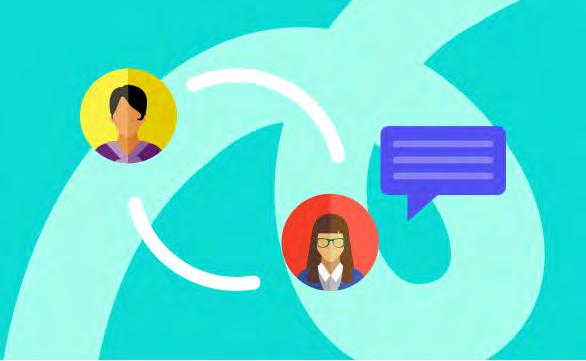
STATE OF THE INDUSTRY RESEARCH 35 ARTICLE
How to Structure an Effective Employee Recognition Program
Recognition isn’t rocket science. However, most organizations just aren’t getting it right. Showing the type of gratitude that binds teams together, improves retention and boosts business should be social, timely, specific, and tied to something concrete.
1. Make employee recognition peer-to-peer
We often think of recognition in terms of topdown (meaning, manager-to-worker) — and plenty of research confirms that employees do value that.
But a multitude of studies also reveals that employees equally appreciate, or even prefer, recognition from their teammates. Why? Colleagues see a higher volume of each other’s daily contributions, giving them more opportunities to get a pat on the back from someone who truly understands their work. So recognition from peers can feel more authentic than top-down recognition, which sometimes comes across as obligatory.
What’s more, having the ability to give and receive peer-to-peer recognition conveys to each and every person within an organization that they have a voice. And don’t we all want that?
2. Give employee recognition in real-time

When extending those kudos, high-fives, or metaphorical gold stars, the sooner the better.
Feedback in general is better given while the subject is still fresh—and recognition is no different. Giving timely recognition ensures:
a. Appreciation happens rather than getting lost on a to-do list or forgotten, and
b. Makes a clear connection in the recipient’s mind between the outcome and their behavior.
3. Make employee recognition clear & specific
A Deloitte study revealed that people most appreciate being recognized in four overarching categories: success, knowledge or expertise, effort, and living core values.
But to have the highest impact, narrow recognition to the exact behavior where someone excelled. If their content knowledge led to a quality decision in a meeting, cheer for that! If they’ve lived out the values of the company in an interaction with a customer, let them know you noticed.
Try this formula: “When you contributed X, it enabled us to achieve Y.”
By tying praise to specific actions, it becomes more meaningful and longer lasting.
How to Create a Culture of Recognition
Recognition creates an environment where people consistently know their work matters — that they matter. Here are some tips for getting started:
STATE OF THE INDUSTRY RESEARCH 36 ARTICLE
Make recognition easy to give and share with technology
So why aren’t we already sharing more recognition? One reason often cited by managers is that it takes too much time.
By making the process of giving recognition intuitive, accessible, and systematized through the use of a digital software platform, you can change the game for a whole company. Making it visually engaging, seamless to use, and easily accessible in mobile format is even more powerful.
Make recognition a year-round practice, not a quarterly or annual event
A simple, sincere “thank you” is the single thing employees crave most (beyond even gifts or celebrations). They just want to be acknowledged for their contributions on a daily basis. Saying “thank you,” frequently builds a strong culture of gratitude, where workers know their efforts are seen and appreciated. Once you’ve built that foundation, big celebrations can feel even more meaningful.
Share recognitions publicly across the company
Many employees thrive when their accolades are shared publicly on a shared company recognition feed. But whether you’re building a culture of recognition from scratch, or trying to change existing patterns, it can take some momentum to get started.
recognition early on during a new implementation of an employee Recognition & Rewards platform. Once a precedent is set of the CEO congratulating an intern on work well done or of Engineering thanking Customer Success for insightful customer feedback, public thank you’s will spread like wildfire.
Attach recognition to meaningful rewards
Recognition alone is a game-changer. But paired with meaningful employee rewards adds a dynamic dimension.
When you layer rewards on top of recognition, you pack a one-two punch when it comes to reinforcing core company values, and incentivizing participation in company-wide initiatives. Some companies allow workers to order company branded clothing, others fund lunch with colleagues of the employee’s choice, others offer access to leadership—like a day golfing with the CEO.
When you let technology do the heavy lifting, recognition is a joy to give and receive. Having a one-stop solution that pulls all the pieces together can make the difference between “Nice idea — I’ll get to it later.” And “Where has this been all my life?”
Make recognition easy with WorkTango

It’s important to get managers and senior leaders involved early. Establish a norm of public praise and
We hope this article helped you understand the link between employee recognition and retention and turnover, and also gave you some great insight into how to build an effective culture of recognition. It’s one of our specialties. And if you like what you’ve read, we’d love to connect.
STATE OF THE INDUSTRY RESEARCH 37 ARTICLE
At WorkTango, we’re revolutionizing how the world’s most forward-thinking companies engage and inspire their people. We offer the only Employee Experience Platform that enables meaningful recognition and rewards, supports alignment through goal setting and feedback, and offers actionable insights through employee surveys.


WorkTango is built for the workplace we all want to be a part of – where priorities become clear, achievements are celebrated, and employees have a voice. So if you’re ready to improve (work) lives, schedule a demo today.
Rob Catalano is WorkTango’s Chief Marketing & Strategy Officer. Rob has spent the last 18 years building HR Technology companies. He was on the founding team at Achievers, where he spent his 10+ year tenure leading their Marketing function as well as the final few years leading their global expansion out of the UK. Rob’s passion for improving the employee experience led to him co-founding WorkTango in 2015 to help companies collect and act on authentic employee feedback.
Would you like to comment?

STATE OF THE INDUSTRY RESEARCH 38 ARTICLE




It’s time to create the employee experience you’ve always wanted. Are you ready to revolutionize how you engage and inspire your people? If so, learn more at worktango.com See for yourself: request a demo using this QR code. WorkTango offers the only Employee Experience Platform that enables: • Meaningful Recognition & Rewards • Actionable Insights through Employee Surveys • Alignment through Goal Setting & Feedback

The State of Rewards and Recognition 2023 Human Experience Excellence • April 2023 For more information: 1.877.472.6648 sales@hr.com www.HR.com/epubs The HR Research Institute tracks human resources trends and best practices. Learn more at hr.com/featuredresearch Special Research Supplement
Calling People Back To The Office Won’t Improve Performance
To achieve performance, everyone needs to know what’s expected of them
By Justin Reinert, Performance Accelerated Learning
An article published on March 25th in The Wall Street Journal contains quotes like:
“There’s a sense that innovation, creativity and collaboration can suffer when teams are apart. [Managers] believe employees are simply more productive in the office. They also feel that it’s important for mentoring and training both new and existing employees.” These are all from Mike Steinitz, senior executive director at Robert Half. Then we have Mark Zuckerburg saying, “Our hypothesis is that it is still easier to build trust in person and that those relationships help us work more effectively.”
I’ve underlined the words that I find problematic in these statements. They are sense, believe, feel, and hypothesis. If those words were uttered in a boardroom anywhere in America, how would they be received? Let me help frame them up:
● “I have a sense that we’re going to hit our target this quarter.”
● “I believe there isn’t a problem with the product that has low sales.”
● “I feel like this will be our best year yet!”
● “Our hypothesis is that performance is good.”
I’ve spent time with various executives over the years, and this may not land well.
On May 26th 2022, Elon Musk tweeted “…stay-at-home stuff has tricked people into thinking that you don’t actually need to work hard.” However, a study in 2021 shows that people worked more hours in the first year of the pandemic.
Here’s the thing, people can be just as unproductive in an office as they can be outside of an office, and vice versa. Butts in seats only get you warm chairs. Let’s figure out what our people need and how they work best and go from there.
I agree that in-person interaction can expedite or enhance training and mentoring. Think about your early career individuals who benefit from side-by-side learning, that can be helpful. But for your seasoned individuals that do a lot of heads-down work, why force them to commute if unnecessary? For many years I held roles in highly distributed organizations. Some of our staff worked closely with a team in one location, but I was typically working with individuals across the US or the globe. When went into an office, I spent most of my time with the door closed and on video or voice calls. Why does anyone need to commute for that?
Human Experience Excellence presented by HR.com April 2023 41 Submit Your Articles
The key here is that organizations need to stop these blanket return-to-office policies and put the power in the hands of the managers. Let them figure out how and where their teams are most productive. We also need to make sure the managers are equipped to effectively manage performance.

Once when I was the head of HR for a midsize organization. One of our team managers talked with me about putting one of his team members on a performance improvement plan. I asked him what performance measures were unsatisfactory, and he responded that the employee needed to be in the office from 8 am to 5 pm. I pushed back and said that’s not a performance measure, and I wanted to know how else he was measuring performance. He couldn’t answer me, so I sent him away and asked him to return when he could clearly articulate performance expectations. It took two weeks, but he eventually returned and said that the employee should be closing 30 cases per month and had only closed 20 cases last month.
Because it took so long for the manager to provide this performance expectation, I arranged for the three of us to meet and get on the same page regarding the performance expectations, given they may need clarification. The employee didn’t realize he was underperforming and was surprised he needed to meet expectations. The following month he closed 40 cases and continued to exceed the goal of 30 cases from there on out. And note that it had nothing to do with the time he was in a seat.
For all of these organizations claiming that they’re not performing at the levels they expect, who has gotten that message? Do your managers have the tools to communicate and track performance effectively? Let’s start at the front-line manager layer and equip them properly. Here are a few things to think about with your teams that can help empower practical remote work and improve work/life balance.
Human Experience Excellence presented by HR.com April 2023 42 Submit Your Articles
Calling People Back To The Office Won’t Improve Performance
● Trust your employees. If you don’t trust your employees to do their jobs when they’re not in the office, then you have a bigger problem.
● Create a culture of trust and collaboration through video conferencing, instant messaging, and other tools.
● Measure results, not hours. If your employees are getting their work done, then it doesn’t matter how many hours they work.
● Be flexible. Only some people work best at the same time or in the same way. Be willing to accommodate different work styles.
● Offer remote work options to all employees to attract and retain top talent.

● Invest in technology. Make sure your employees have the tools they need to be successful when they’re working from home.
Right now, we’re seeing the world of work change before our eyes as new AI technologies emerge and drastically shift how we work. Technology changes
will require today’s and tomorrow’s leaders to be flexible, adaptable, and effectively set expectations in a constantly shifting environment.
Justin Reinert is a Talent Leader with 20 years of talent development experience. He has led learning at organizations as large as HSBC and Oracle and built award winning learning teams at small to mid size high-growth firms. He’s currently the Principal and Founder of Performance Accelerated Learning and recently published his first book, Creating Belonging, in the spring of 2022.
Would you like to comment?

Human Experience Excellence presented by HR.com April 2023 43 Submit Your Articles
Calling People Back To The Office Won’t Improve Performance
HRCI® & SHRM® CERTIFICATION PREP COURSES
GROUP RATES AVAILABLE
For HR Professionals
Show that management values the importance of the HR function, and has a commitment to development and improvement of HR staff.
Ensure that each person in your HR department has a standard and consistent understanding of policies, procedures, and regulations.
Place your HR team in a certification program as a rewarding team building achievement.
For Your Organization
Certified HR professionals help companies avoid risk by understanding compliance, laws, and regulations to properly manage your workforce.
HR Professionals lead employee engagement and development programs saving the company money through lower turnover and greater productivity and engagement.
A skilled HR professional can track important KPIs for the organization to make a major impact on strategic decisions and objectives, including: succession planning, staffing, and forecasting.
HR.com/prepcourse CALL TODAY TO FIND OUT MORE 1.877.472.6648 ext. 3 | sales@hr.com
Why Certification is the Best Choice:
1 Less expensive than a masters or PhD program, and very manageable to prepare with flexible study options.
2. Recertification - ensures HR professionals continue to be up to speed on the latest legislation and best practices
3. Recognized, Industry benchmark, held by 500,000+ HR Professionals
Group Rate Options
We offer group rates for teams of 5+ or more for our regularly scheduled PHR/SPHR/ SHRM or aPHR courses.
For groups of 12+, we can design a more customized experience that meets your organization’s needs. You can have scheduling flexibility in terms of the days, times, and overall length of the course.
Groups rates for HRCI exams are also available as an add-on.
All group purchases come with 1 year of HR Prime membership for each attendee to gain the tools and updates needed to stay informed and compliant.

CALL TODAY TO FIND OUT MORE 1.877.472.6648 ext. 3 | sales@hr.com | HR.com/prepcourse
1 2 3
Return To Office: Hot Desking And The Power Of Flexible Workspaces
Empowering companies to optimize their hybrid workforce
By Robyn Rawlings, Webex by Cisco
For the better part of the last few years, millions of employees have clocked in from the comfort of their own home. Now, eager to return to a state of normalcy, many organizations are asking employees back to the office (at least, to a certain extent).
The problem? A smooth return to the office is easier said than done. In fact, research shows that 82% of decision-makers are concerned about successfully getting employees back to the office this year. Employees want freedom—not just in terms of where they work, but how they work, too.
Enter hot desking: an innovative workspace solution that’s bringing flexibility to the modern workplace. But what exactly is hot desking? How does it work? And, most importantly, how can your organization benefit from implementing it?
What is Hot Desking?
Hot desking refers to a flexible seating arrangement wherein your employees can book and use a workstation anywhere in the office on an ad-hoc basis—that is, if it hasn’t been reserved already. As an alternative to the traditional fixed-desk setup, this approach allows people to freely work wherever they feel comfortable on any given day.
The goal is simple: Optimize available office space, maximize efficiency, and minimize redundancies wherever possible. In theory, this translates to a more productive (and more harmonious) office environment.
Hot desking is far from a new phenomenon. In fact, CitiBank became an early pioneer of the concept in 2014. After realizing much of their office space was underutilized, the company introduced flexible workstations that made better use of real estate. Now, as more organizations return to the office using a hybrid work model, employees are expecting a similar degree of freedom. In some cases, where companies are forcing employees back to the office full-time, workers are pushing back strongly against their mandates. Some have even successfully convinced employers to reverse course and return to a hybrid policy.
Benefits of Hot Desking
Hot desking has its critics, but it also has a series of undeniable benefits. More than a seating arrangement, the hot-desk approach is a great way to strategically empower your workforce and support overarching business goals. Let’s dive into the advantages:
Human Experience Excellence presented by HR.com April 2023 46 Submit Your Articles
TOP PICK
● Cost savings: As reported by Forbes, hot desking reduces costs because it allows for smaller office spaces where equipment, facilities, and utilities are all shared by employees as they come and go.
● Collaboration: Hot desking encourages employees to change up their seating arrangements regularly, affording them more time with colleagues from different departments. This supports cross-functional productivity, breaks down communication barriers, and helps build a stronger company culture.
● Organization: Because employees are using new workstations all the time, there’s a lower chance their desks will become cluttered with knickknacks, belongings, and office supplies. This not only makes for a tidier workplace but also can encourage productivity as employees spend less time on upkeep and more time on work and creativity.
● Retention: With the freedom to work wherever they’re most comfortable, employees can enjoy an in-office experience that fits their unique work style. This autonomy can translate into better workplace engagement, alleviating burnout and reducing employee turnover.
● Insights: Perhaps the best way to manage a hot desking setup is through a centralized dashboard. Not only does this make it easy to book workstations and oversee their usage, it’s also a great way to identify target









improvements. By linking a centralized dashboard with your hot desking setup, you’ll get a range of data on space usage, allowing you to spot trends and make informed decisions about space allocation.
Hot Desking Tips and Best Practices


When introducing a new hot desking setup, take some time to carefully consider everything you need to make a seamless transition. Otherwise, employees may not embrace the change. To ease the process, let’s take a look at a few tips for setting up a hot desking policy:
1. Make it make sense
Before you get started, make sure that hot desking is a good fit for your company. Circumstances may vary depending on your work model, so think about how hot desking would work in each scenario:
● Hybrid work model: Hot desks are great for people who come in on certain days, but work from home the rest. This ensures everyone always has a workstation whenever they’re in the office.
● Office-first model: Even if you’re fully in-person, hot desking supports cross-functional teamwork and encourages people to move about the workplace. Plus, even visitors such as vendors, clients, and business partners can use the hot desk for their own business needs.
● Fully remote model: Do you have a distributed workforce? If so, hot desking can still work in your favor. Whether at a coworking location or in the office, hot desks offer employees an alternative to remote work, should they need it.
2. Use wayfinding to your advantage
Wayfinding literally refers to the process of finding your way around the workplace. It includes any physical or digital system you use to help employees navigate the office, from physical maps and digital floor plans to more advanced devices that connect video conference schedules, room controls, and room booking.

Human Experience Excellence presented by HR.com April 2023 47 Submit Your Articles
Return To Office: Hot Desking And The Power Of Flexible Workspaces
How does wayfinding relate to hot desking?
Fundamentally, wayfinding helps people find available workstations. But, as more advanced technology is adopted, wayfinding solutions can also encompass room booking and scheduling, environmental monitoring, room controls, and more. With desks switching every day, it can become confusing (and time-consuming) to look for open space. Wayfinding allows you to cut down on search time and get people where they need to be faster.
3. Equip desks with the right technologies
What good is a workstation if it doesn’t make work easier? According to Kantar, 64% of hybrid or on-site workers take calls and virtual meetings at their desks.
That’s why it’s key to outfit your hot desks with all the essentials: USB ports, softphones, video conferencing devices, cameras—basically, anything you would need to collaborate in the modern workplace.
4. Complement workstations with bookable meeting rooms
Sometimes, people need privacy—or at least some peace and quiet. Aside from hot desks, bookable meeting rooms offer employees a secluded place to get away from the hustle and bustle of the office and still get their work done.
Ensure your rooms are also set up with collaboration devices that make it just as easy to join meetings,
collaborate, and stay productive. Cisco Room Kits, for example, transform ordinary rooms into fully functioning video conferencing suites.
Supporting Your Flexible Future
Before you jump back into the full swing of things in the office, take a minute to consider the power of hot desking. More than a trend, hot desks are a great way to support your hybrid workplace and provide employees with freedom of choice. With a structured, tech-driven way to book workstations and meeting rooms, you can prepare your company for a successful return to the office.
Robyn Rawlings is the Director of Integrated Campaigns and Content Marketing at Webex by Cisco, a leader in cloud calling, collaboration, and customer experience solutions. Previous to Cisco, Robyn held leadership positions at CA Technologies and various small start-ups where she drove programs in digital marketing, thought leadership, corporate marketing, product marketing, and customer advocacy.
Would you like to comment?

Human Experience Excellence presented by HR.com April 2023 48 Submit Your Articles
Return To Office: Hot Desking And The Power Of Flexible Workspaces
The Return To Work: Navigating Myths And Realities Of Remote And In-Person Work

The future of flexible work arrangements
By Becky Cantieri, Momentive
There are two myths—or at least, simplifications—that are going around the internet right now about the return to work.
One asserts that “the remote revolution is over;” that it’s time to go back to the office for good, and that the work from home
structures that companies put into place during the pandemic should fade away. The other presents the return to office as a kind of power struggle in which unsympathetic bosses force their resentful employees back into an in-person model that they despise (perhaps exemplified by Elon Musk’s infamously unpopular decision to do so at Twitter). But neither narrative is wholly accurate.
As interest in returning to the office overtakes interest in enabling remote work, it’s important to consider the mental health ramifications, impact on diversity, equity, and inclusion, and other important benefits- and wellness-related outcomes that go hand-in-hand with returning to the traditional workplace.
Human Experience Excellence presented by HR.com April 2023 49 Submit Your Articles
Is It Really Surprising that People Actually Like Going to the Office?
Research shows that most people (57%) actually prefer working in an office or workplace over working from home. After all, being with colleagues (and out of the house) can be good for our mental health. In-person workers reported finding it easier to focus and get things done at the office, and many people miss the social aspect of work—getting to know colleagues over coffee or heading out to lunch with work friends on a Friday.
In-person meetings also give workers an opportunity to collaborate more easily and enjoy quality bonding time with coworkers – a benefit they cannot as readily enjoy in online

meetings. Zoom fatigue is both well-documented and largely unavoidable—especially if one works from home.
More importantly still, being physically present in the office can be a critical piece of getting recognition and opportunity for professional advancement. The BBC cites multiple studies that have found that remote workers are more likely to be overlooked (despite often being more productive). Being in the office makes exposure more equitable, so that the right people get recognized for the hard work they put in.
Being physically present in the office can also serve as an opportunity for professional advancement. The BBC cites
multiple studies that have found that remote workers are more likely to be overlooked (despite being often more productive).
And unless your company intentionally and purposefully prioritizes leveling the playing field for remote and in-person workers by making recognition equitable and company culture inclusive no matter where an employee works, being in the office makes exposure more equitable. Therefore, the right people get recognized for the hard work they put in.
So, does all this go to say that the remote revolution is really dead after all? Not exactly. Remote work is empowering and equitable, and opens the door to new opportunities
Human Experience Excellence presented by HR.com April 2023 50 Submit Your Articles
The Return To Work: Navigating Myths And Realities Of Remote And In-Person Work
First, the most obvious complication: despite the majority preference for working in office, there is still a sizable contingent of folks who prefer to work from home. In fact, 11% are willing to quit their jobs over it.
Critically, Remote Work Plays an Essential Role in Accessibility and Inclusion

Neurodiverse employees, for example, are often overwhelmed by the cacophony of stimulation in an office, which makes it impossible for them to focus and do their jobs well. Similarly, people with chronic illness may need to work from home in order to be able to access healthcare, take rest when they need it, or simply stay comfortable enough to be productive. For parents and caregivers too, being forced to report to an office might be a dealbreaker that prevents
incredibly talented people from staying in a role.
Hiring remote workers also expands the pool of potential candidates for a company. People who live in rural or underserved areas can now access jobs traditionally located in areas like Silicon Valley or Manhattan. This can ultimately lead to a more diverse workforce with an array of perspectives.
Remote work offers people flexibility: the chance to travel, care for their families, take care of their own bodies and minds. Many people also consider themselves significantly more productive at home. And companies have the capacity to support employees that want to do this. At the height of the pandemic, 70% of white collar workers were fully remote That means that the infrastructure is there. Companies already have the software and processes that
they need to let employees work remotely.
The Remote Revolution Isn’t Over
Quite honestly, it’s just getting started as companies experience the benefits of having a diverse, global workforce that prioritizes mental health and wellness. At the same time, corporate offices aren’t going away; they play an important role in fostering collaboration and community. What the future actually holds, most likely, is a mixture of both.

Forward-looking companies are already allowing their employees to choose the work structure that works best for them, knowing how the pros and cons of each option will impact them personally. Many people are also tapping into the best of both worlds with hybrid work options, spending a few days each week in the office and a few remote.
Flexibility and individual empowerment: that’s what the future of work really looks like— and we all stand to benefit.
Would you like to comment?
Human Experience Excellence presented by HR.com April 2023 51 Submit Your Articles
Becky Cantieri is the Chief People Officer at Momentive
The Return To Work: Navigating Myths And Realities Of Remote And In-Person Work
The Next Step For Worker Experience
Extending a hand to extended workers
By Sam Smith, Magnit
Weall know the building blocks of a positive worker experience. Competitive compensation, open communication, clear expectations, and consistent recognition all motivate skilled employees to stick around—which is increasingly important in today’s labor market. As awareness of these expectations has grown among managers and leaders, they’ve invested in curating satisfying, worker-centered corporate cultures. However, many have stopped short of extending those efforts beyond full-time staff.
While work experiences have improved by leaps and bounds for full-time employees, contingent and contract workers have been left behind. Recent research shows that nearly 50% of the enterprise workforce is now contingent, and that number is growing exponentially. Soon, “flexible” workers will just be workers—and employers will need to re-evaluate their approach to engaging with this growing demographic.
Bridging the Gap
The foundational elements of the contingent worker experience will be familiar to leaders. Still, providing these offerings to extended workforces can come with unique challenges, as the information and tools contingent workers need may vary from their full-time counterparts.

To ensure contingent workers’ experiences are on par with full-time employees, managers should:
● Establish a direct sourcing program. For years, businesses have turned to staffing agencies and other third parties to find contingent candidates. When companies bring the process in-house, it gives them visibility into the process, their workers’ performance, and the demographics of their integrated workforce. Furthermore, this approach can help enterprises with contingent workers leverage their existing employer brand to help contingent employees feel like part of the company rather than an outsider looking in.
Human Experience Excellence presented by HR.com April 2023 52 Submit Your Articles
TOP PICK
● Reimagine their onboarding with flexible workers in mind. Perhaps the most daunting part of starting any new job is learning the ropes, and a comprehensive onboarding program can help ease that process. Unfortunately, many flexible workers are left out of these initiatives because of the nature of their working arrangement—and that can spell trouble for redeployment efforts, morale, and productivity. As flexible workers become more common, managers will need to redesign onboarding programs to address concerns unique to this group.
● Assess current benefits, technologies, and perks to ensure they meet extended workers’ needs. The needs of extended workforces may differ from those of full-time workers due to their location, the terms of their contract, the type of work they do, and countless other factors. All of these elements may affect whether the benefits a business offers to its staff adequately support a growing contingent labor pool. For example, a business’ top-of-theline health insurance option may not be so great for remote workers in another state or country. Contingent workers increasingly working across borders could make your offerings less enticing.. Similarly, perks like same-day pay may not be available to contingent employees with a different payroll processor and internal workflow tools may not function for external users without special permissions. Failing to account for these disparities and remedy them can lead to unsatisfied flexible workers and reduced productivity.
● Prioritize visibility and transparency. Coming into a business as a temporary employee can be alienating—especially when recruitment processes, HR issues, accommodation requests, and more may be handled externally. Contingent employees can struggle to find the resources they need to do their best work and understand internal expectations or workflows that long-term employees may take for granted. Investing in tools that promote visibility, provide guidance, and encourage feedback can go a long way toward making flexible workers feel like part of the team.
● Invest in integrated management tools. At the core of the improvements employers have made to full-time employees’ working lives has been the wealth of data and insight available in modern enterprises. Investing in a comprehensive, integrated workforce management platform can help yield similarly useful insight into contingent talent. This information empowers managers to contextualize their contingent workforce within the larger organization and better understand any experience or access gaps that may be present, helping employers make more informed decisions about what’s next for their staff.
One Step at a Time
Of course, these changes won’t happen overnight. Just as progress toward a more satisfying full-time worker experience took time, so too will improvements for the emerging extended workforce. Success will be built on small steps forward—and the path will be unique to each business. However, understanding the above will set employers well on their way to bridging the gap between what they can offer to full-time and flexible workers.
Sam Smith is President of EMEA and Global Client Delivery at Magnit. Sam is an accomplished transformation leader and is responsible for helping grow Magnit’s presence in EMEA. She specializes in a range of business functions including program delivery, global sourcing, change management, managed services, and talent supply chain management. Sam possesses deep domain knowledge in high-volume staffing and a first-hand understanding of the challenges facing contingent workers. She has over 25 years of experience in helping the world’s leading brands reimagine their contingent workforce management programs.

Human Experience Excellence presented by HR.com April 2023 53 Submit Your Articles The Next Step For Worker Experience
you like to comment?
Would

ePublication EditorialCalendar2023 Checkoutthenewandupcomingthemed HRtopicsinHumanExperienceExcellence -Engagement,Performance,Rewards &Recognition Check ePublications Editorial Calendar Here. Would you like to submit an article? | Write to us at ePubEditors@hr.com Submission Guidelines 1 Employee Productivity May 2023 2 The Future of Diversity, Equity, Inclusion and Belonging Jun 2023 3 Corporate Social Responsibility Trends Jul 2023 4 Workplace Communication and Engagement Aug 2023 5 The State of Human Experience in the Workplace Sep 2023
How To Prevent Workers From Asking “Why Am I Here?”
Using Herzberg’s two-factor theory and Marrujo’s Cycle of Satisfaction Model
By David Marrujo, Colorado Technical University
Frederick Herzberg maintained that job satisfaction has two-factors to be considered; the opposite of satisfaction is not dissatisfaction; and the opposite of motivation factors are hygiene factors. (masterclass.com) By now, some people trying to make sense of all this would think it is too difficult to explain human behavior in the modern world. Well, it is and it isn’t.
Years ago, a highly successful aerospace technology company was experiencing a significant (high for the times) annual voluntary termination rate of 16% vs an industry average of 11%. Departing employees were asked to complete an “Exit Interview Questionnaire” including the following:
“Why are you leaving?”
“Is there anything we could have done to change your mind?”
“Will you recommend us to your friends?”
Upon completion of this simple instrument, the employee received their final paycheck and was “free to go.” Since any meaningful data was not collected, any guess was as good as any to conclude
from the employee responses why someone was leaving. In fact, there were no follow-up steps and senior management had no effective means of turning the situation around other than offering more compensation; but that risked the embarrassment of everyone involved and jeopardized a justifiable offer to future departees. Why try to convince someone on their last day who was voluntarily leaving, how valuable they are to the organization? (“It’s a waste of your time, and it just ends up annoying the other person.”)
The instrument was expanded to 20 questions and responses were discussed in a person-to-person meeting for follow-up and clarification. After a short passage of time and several meetings, distinctive patterns appeared regarding reasons for leaving which were shared with senior managers. Often, specific names were repeatedly mentioned as “individuals directly responsible for people wanting to leave.”
The ER Manager called this model “The Cycle of Satisfaction.” (Figure 1) The title was chosen because it related to “job satisfaction;” and using the term “happiness” could be difficult to gain consensus among others as to what that entailed.
Human Experience Excellence presented by HR.com April 2023 55 Submit Your Articles
The top of the figure is labeled “Challenge.” Having a meaningful job assignment and a “high profile” assignment were frequently mentioned by the technical staff. The job duties and missions had become mundane and less challenging, and the need for autonomy was important to the high achievers.

Following the circle around, “Recognition” is listed next in importance. The employees were often disappointed at the few times “Thank You” was heard from their managers. To hear praise, especially from a significant person, means a lot to most people. It meant a lot to these high achievers.
Next, on the cycle is “Reward.” Usually, this meant pay, benefits, promotions (earned measures of advancement in the organization), or a type of fitting reward. Contrary to popular belief, employees did not
list money as their number one reason for leaving. There were other factors more important to them.
Finally, the cycle stops at “Support.” Since these were very technical workers used to having the latest and greatest in hardware, software, systems, and tools; they wanted to demonstrate professional results in their daily efforts. They were also hoping for future development opportunities to advance in the organization and not just skills training for their current roles.
However, the primary source of support they wanted was from their supervisor/manager. Many had based their reason for wanting to leave on the shortcomings of their management. (“People don’t leave companies, they leave managers.”) Some had experienced hostile work environments; some did not have faith or trust in their management; while others doubted their managers truly cared about them as individuals.
Human Experience Excellence presented by HR.com April 2023 56 Submit Your Articles
How To Prevent Workers From Asking “Why Am I Here?”
Figure 1
Herzerberg’s Two-Factor Theory
Herzberg had reasoned quite simply that the level of motivation in the workplace would have a direct effect on productivity. He believed that having the motivation to work was tied to workers having a greater sense of purpose and significance in their current position. (simplepsychology.org) The list includes:
● Performance and Achievement
● Recognition
● Job Status
● Responsibility
● Opportunities for advancement
● Personal Growth
● The Work Itself
Herzberg believed that improving these factors helps to increase job satisfaction. (simplepsychology.org)
In addition, Herzberg reasoned that Hygiene factors needed to be addressed independently in order to
keep employee dissatisfaction at bay. (simplepsychology.org) The list includes:
● Salary
● Working conditions
● The physical workspace
● Relationship with colleagues
● Relationship with supervisor
● Quality of supervisor
● Policies and rules
Herzberg believed that improving these factors helps to decrease job dissatisfaction----the need to avoid unpleasantness. (simplepsychology.org)
The Cycle of Satisfaction and the Two-Factor Theory
(Figure 2) shows Herzberg’s Two-Factor labels superimposed above the corresponding elements on The Cycle of Satisfaction Model.

Human Experience Excellence presented by HR.com April 2023 57 Submit Your Articles
How To Prevent Workers From Asking “Why Am I Here?”
Figure 2
There is one more feature in the Cycle model important to note which described the likelihood of retention. In the center of the circle, there were elements which described the psychological connection of the Individual with the Organization’s Culture. These included a person’s combination of:
● Values
● Wants
● Needs
● Beliefs
● Interests
● Feelings
The elements became important to note once shared in the personal interviews and shed light on how closely the Individual matched the characteristics found in an Organization’s Culture. These shared elements described a relationship between the Individual and the Organization. Even if a departing
employee perceived the four stops on the outer circle (Challenge, Recognition, Reward, and Support) to be weak or even missing; the employee was often willing to give the organization “another chance of retention.” However, it was just a matter of time before a change was inevitable.
It’s been said that “business is all about relationships;” how one relates to their managers, direct reports, co-workers, peers, customers, clients, and vendors. A departing employee often was willing to stay in the professional relationship until there was a perceived “break’ in the bond. This is similar to when two parties are in a personal relationship and one side experiences “the feeling of being taken for granted;” the question arises, “Why am I here?” This would mark the beginning of the end of the relationship between the Individual and the Organization. All that was necessary would be another employer offering Challenge, Recognition, Reward, and Support; and the employee would make plans to voluntarily terminate.

Human Experience Excellence presented by HR.com April 2023 58 Submit Your Articles
How To Prevent Workers From Asking “Why Am I Here?”
A final note regarding the relevance and simplicity of The Cycle of Satisfaction Model and its connection to the Herzberg Two-Factor Theory is that the Cycle was created 25 years ago and is still in use. The Cycle of Satisfaction is a simple model and is easy to remember.
In conclusion, supervisors and managers should take time to learn about their employees--ask good questions, actively listen; and find ways to Challenge, Recognize, Reward, and Support their most valuable resource. Members of management should improve on the known Motivators and Hygiene factors unique to their people and thereby improve job satisfaction and decrease job dissatisfaction. Consistent efforts should be made to develop strong professional
relationships to increase the likelihood of employee retention. The hope should be employees would not be driven to ask themselves, “Why am I here?”

References
● Masterclass.com/how-to-use-herzbergs-two-factor-theoryto-boost-worker-productivity. Retrieved from https://www. masterclass.com/articles/how-to-use-herzbergs-two-factor-theory-to-boost-worker-productivity Accessed February 17, 2023
● Simplypsychology.org/herzbergs-two-factor-theory.html Retrieved from https://www.simplypsychology.org. Accessed February 17, 2023
● “The cycle of satisfaction,” Marrujo, D.A. (1998). Revision 2023, copyright pending
David Marrujo has over 30 years of experience in Human Resources and successfully fulfilled various generalist assignments in corporate headquarters and field locations. His HR roles included: employee relations, staffing, compensation and benefits, affirmative action, performance management, diversity, and ethics. After working at various local colleges in metro Denver, David joined Colorado Technical University in 2005 where he is an Adjunct Associate Professor in the College of Business and Management. He has been nominated twice for CTU Distinguished Faculty honors and won the “2013-14 Distinguished Educator for Instruction” Award.
Would you like to comment?

Human Experience Excellence presented by HR.com April 2023 59 Submit Your Articles
How
To Prevent Workers From Asking “Why Am I Here?”
VIRTUAL EVENTS
The Future of Payroll: New Trends and Global EORs
April 20, 2023
Successful Talent Management Strategies From Hire to Retire
April 26, 2023
EmpowerHR TA/DEIB 2023
May 16, 17, 2023
View our Upcoming Virtual Conference Schedule and Register Today!
WEBCASTS
Skills vs. CVs: The Power of Skills-Based Hiring in 2023
April 19, 2023
12:00 PM - 1:00 PM ET
Everything You Need to Know About EORs
April 20, 2023 11:00 AM - 12:00 PM
How Nevada County Reduced Time to Hire From 136 Days to 48 Days
How to Hire Full Time and Contract Workers Internationally
April 26, 2023 11:00 AM - 12:00 PM
April 27, 2023 12:00 PM - 1:00 PM
View our Upcoming Webcasts Schedule and Register Today!
REGISTER
REGISTER
REGISTER
REGISTER
ET REGISTER
ET REGISTER
REGISTER
EVENTS & HR.COM WEBCASTS UPCOMING
ET
VIRTUAL
www.hr.com/upcoming_webcasts www.hr.com/virtualconferences
Thank you for partnering with us!
Paycom (NYSE:PAYC) offers cloud-based human capital management software to help businesses streamline employment processes, from recruitment to retirement. With a robust suite of products including payroll, time and labor management.

LEARN MORE
Jobvite is a comprehensive talent acquisition suite that powers a marketing-inspired recruiting approach from first look to first day.

THANK YOU
PARTNER WITH US
Designing better ways to work by providing cutting-edge products and exceptional experiences within HR, Talent, Time Management, Benefits and Payroll.

MORE
LEARN
MORE
LEARN








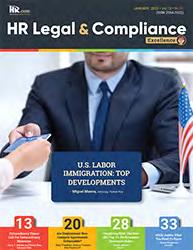


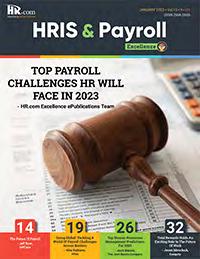
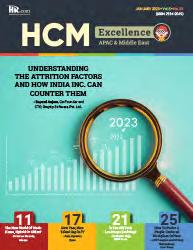
Like to submit an article? Use our online submission form or for more information go to www.hr.com/ExcellencePublications Publications 13 Targeted Publications to Reach Your Audience Informing, Educating, Enlightening and Assisting HR professionals in their personal and professional development, the Excellence series offers high-quality content through the publications!


































 Dave Ulrich
Rensis Likert Professor, Ross School of Business, University of Michigan Partner, The RBL Group
Dave Ulrich
Rensis Likert Professor, Ross School of Business, University of Michigan Partner, The RBL Group
















 By Rob Catalano, WorkTango
By Rob Catalano, WorkTango



























































